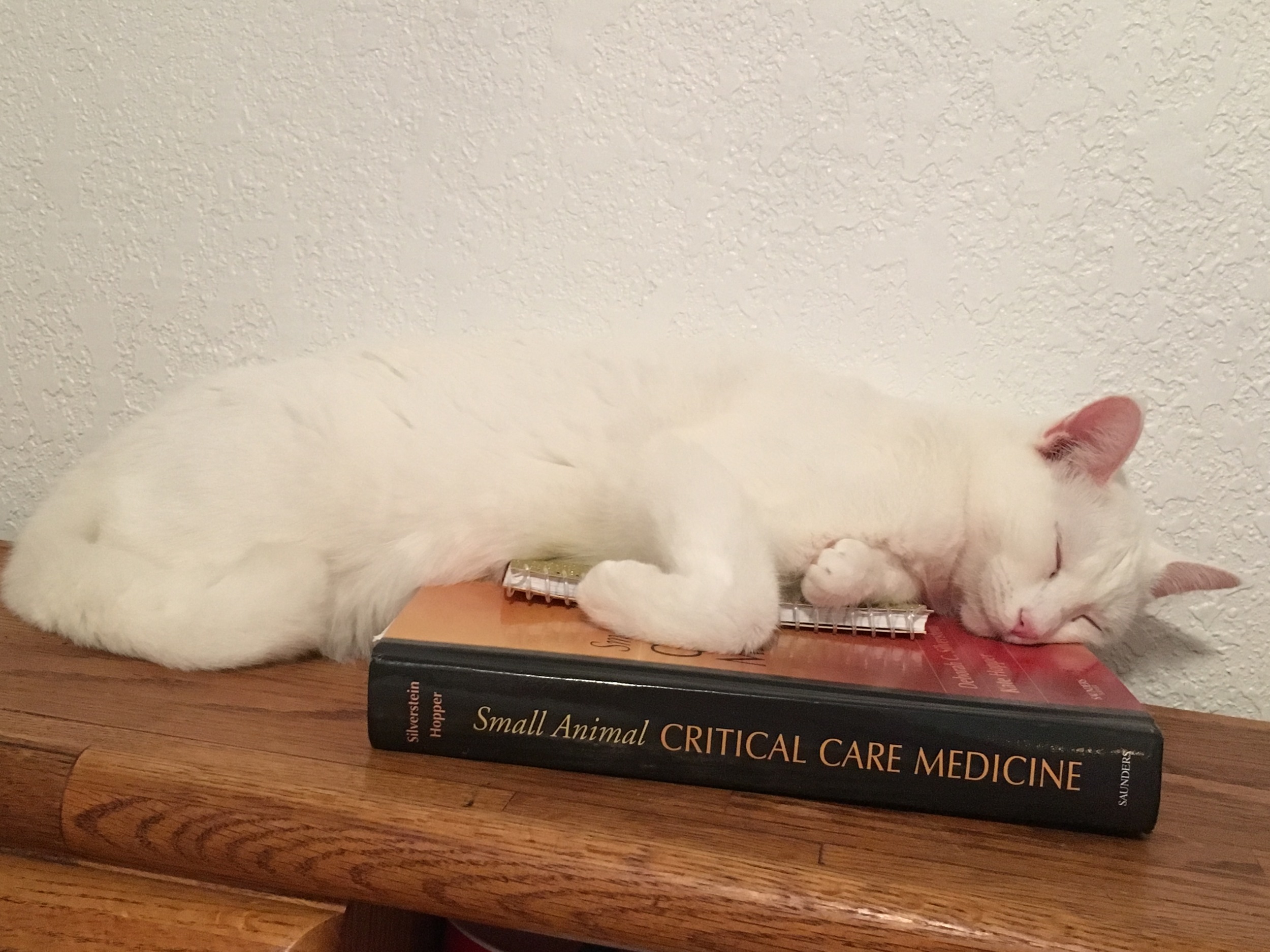I work primarily with non-profit organizations, shelters, animal rescues and on Sundays, I work at vaccine clinics in pet stores. My interactions with the public during these Sunday clinics have made me realize there is a great deal of confusion about dental disease in pets amongst the general public. Many owners are unaware of the severity of the disease and suffering their pet is experiencing. Many of these pets get vaccines year after year from these pet store vaccine clinics, and have not entered a full service veterinary clinic for a complete and thorough exam and veterinary advice for many years, if ever.
When I point out the severity of their pet's dental disease and explain how they need to go to a full service veterinarian for treatment, people are often reluctant to take my advice because they are worried about the cost. They ask me if there are any products they can use at home instead. Unfortunately, when tartar and plaque build up too much, and the pet has gingivitis and gingival recession have set in, trying to treat with products at home becomes a futile task. In this article, I will discuss how to get the most value out of dental care for your pet.
As a veterinarian who works for non-profits, and is heavily involved in animal welfare, my goal is to be able to help as many animals as possible, provide them with the best care for the lowest cost. I seek no financial gain in making these recommendations, I don't profit from performing dentals, these are just the facts and my goal is to reduce animal suffering and improve the human-animal bond.
Dental disease is a huge problem causing pain and illness for the pet, as well as bad breath that can limit the closeness you feel towards your pet. Because of this enormous problem, many companies have started to crop up in an attempt to capitalize on this “pain point”. Beware though, many of these new products will just waste your money and not help your pet, and some can do more harm than good.
Before dental disease takes hold, the gold standard in preventative dental care is daily tooth brushing. Be sure to only use toothpaste intended for pets, not human toothpaste. Start when they are young and that will make the process easy and enjoyable. For step by step instructions on how to brush your dog’s teeth visit http://www.veterinarypartner.com/Content.plx?P=A&A=171. Here is a great video about how to examine and brush your dog’s teeth https://www.youtube.com/watch?v=PsNlLLSBWLU.
Additional products such as food, gels, water additives and treats that promote dental health can be effective as well, but beware of those products that don’t work at all. To sort through the weeds visit the Veterinary Oral Health Council (VOHC) website (http://www.vohc.org/accepted_products.htm). The VOHC is a group of veterinary dentists and dental scientists that seeks to recognize products that meet standards of plaque and tartar reduction. Their goal was to find an effective means of recognizing products on the market that actually work. Unfortunately though, they are veterinarians and scientists, they don’t know anything about marketing, and sadly their website shows it. But, it contains good information, just no glitz or glamour because they are not trying to sell you anything!
Many products without the VOHC seal of approval can actually be dangerous for your pet. Many water additives available at pet stores have xylitol in them which is toxic to dogs! One good water additive, with the VOHC seal of approval is HealthyMouth, you can check this product out at https://www.healthymouth.com/.
At your yearly veterinary exam, your veterinarian will closely examine your pets teeth. Let them know if you have noticed any changes in your pet’s mouth or breath. If your veterinarian sees build up of tartar, plaque, gingivitis, fractured teeth or other problems, they will recommend a “dental” under anesthesia to investigate further. Severe and prolonged dental disease can lead to bone loss around the teeth, fractured mandibles, heart, liver and kidney problems. Many scientists believe chronic inflammation in humans can lead to cancer formation. Likewise, chronic inflammation in the mouth of your pet may also put your pet at risk for cancer.
For a great list of frequently asked questions about dental disease in pets please visit this page: http://www.wellpets.com/faqs/#15 I am not affiliated with him in any way, but he does have a fantastic website with great content.
Many owners will state that their pets acted years younger after a dental cleaning and treatment. Before the dental, they were living with chronic pain, and their owners never realized it. After the treatment, and painful teeth were treated, the pets suddenly appear happier again.
When preparing for a dental cleaning and treatment for your pet it is important to understand what you are getting for your money. The cost of the procedure can vary widely depending on the level of care your veterinarian is able to provide, and a $200 procedure may not be the same as a $1000+ procedure.
In the past, anesthesia was more risky, you may have even heard of a pet dying during or after a dental in the past. Nowadays with modern technology, anesthesia is relatively safe, but you want to make sure your veterinarian is up to date on the current standard of care. Many older veterinarians, even some with television shows, are not performing dentals using modern standards that increase safety. Modern techniques prevent common problems with anesthesia that include: hypothermia, dehydration and pain. Pre-anesthesia bloodwork is important to determine if your pet’s organs can handle the anesthesia medications and metabolize them effectively. Underlying organ disease can cause problems with anesthesia.
The following list are the bare minimum services a dental procedure should include:
- a full set of dental radiographs
- pre-anesthesia bloodwork
- an IV catheter and IV fluids
- endotracheal intubation, oxygen and inhaled anesthetic
- patient warming during anesthesia with circulating warm air (a BAIR hugger or similar)
- anesthesia monitoring including SPO2, ECG, temperature and blood pressure
- supragingival scaling, subgingival scaling, polishing and lavage of gingival sulcus.
- pain medication during and after the procedure
- local blocks (like novocaine) if any extractions (removal of teeth) is performed.
Take the above list with you and talk with your veterinarian about what they offer.
Why Does My Pet Need Dental Radiographs?
Many veterinarians point out that dental radiographs increase the cost and make it less likely that owners will be able to afford a much needed dental for their pets. Many veterinarians feel that even if owners are unwilling to pay for dental radiographs, they can still do a decent job and help the pet feel more comfortable while limiting the cost to the owner. This is the nature of the veterinary profession, to want to help animals while limiting the cost to the owner. We want to make it as affordable as possible because we want to be able to help the pet.
However, studies have shown that in a large percentage of cases, dental radiographs uncover clinically significant findings in what would appear to be superficially normal looking teeth. How awful would it be to have just spent hundreds on a dental for your pet and then a week or two later your pet's face is swollen because there was an abscessed premolar that looked normal at the time of the dental, but dental radiographs uncovered that it should have been extracted? Dental radiographs do increase the cost, but it is usually 10-20% of the total cost of the procedure and well worth it. The pet is already under anesthesia for the dental, you might as well do it right.
To read more about the studies showing the benefit of dental radiographs click here.
Why are dentals so expensive?
Dentals take a lot of time and expensive equipment, there is no way around that. Many believe veterinarians are getting rich off of recommending unnecessary dental procedures and that just isn’t the case. There are too many animals that need real care and too little time to make up problems that don’t exist. Veterinarians got into this field for the love of animals, not to make money. If they became veterinarians to make a lot of money, they were very unwise. The average salary of veterinarians is declining, while student loan debt and the cost of equipment and medications has gone up.
The average salary of a veterinarian is about $91k a year according to the 2011 Bureau of Labor Statistics. Becoming a veterinarian takes 8+ years of schooling, and most new graduate veterinarians have $150,000+ in student loans and 8+ years of lost earning potential while in school. Veterinarians make the same amount as physician’s assistants and many nurses which takes less education.
The cost of supplies for veterinarians has increased dramatically. For example, just 3 years ago, the cost of a box of IV fluids was about $20, now it is around $100. Many generic antibiotics such as doxycycline have skyrocketed in price by 10x. The cost of anesthesia monitoring equipment and anesthesia machines can cost $10,000 and need to be serviced and replaced periodically. Dental radiograph equipment can also cost $40,000+ and ultrasonic dental scaling and polishing machines and tools can cost $5,000+ and need to be serviced and replaced regularly.
Most veterinarians wish they could provide their services free of charge, and all the supplies, equipment, labor and real estate that goes into providing care would not cost any money, and all pets could be treated for free, but unfortunately, that is not the case.
You can read more about the financial problems facing veterinarians in this article: http://www.newswise.com/articles/view/627812/?sc=swhr&xy=5025791.
Anesthesia-free pet dentistry (AFD) is becoming more prominent. Unfortunately, this service is doing more harm than good to pets. It is tempting to believe their claims because it offers a cheaper alternative, and no anesthesia. But, if it is too good to be true, it probably is. For more information, you can visit Dr. Tony M. Woodward’s website, where he posted a fantastic article on AFD and documented cases he has seen of pet’s suffering from the aftermath http://www.wellpets.com/anesthesia-free-vet-dentistry/.
Why Aren't There Low Cost Dental Clinics Like Low Cost Spay/Neuter Clinics?
I work for low-cost non-profit spay-neuter clinics and have often pondered if it could be possible to set up a low-cost dental clinics. The goal would be to decrease the cost to pet owners and provide the valuable dental treatments these pets need. I have run the numbers and I do not think it is possible to perform this service better and for less money than what full-service veterinary clinics are currently providing without a significant multi-million dollar endowment from a generous donor.
Non-profit spay neuter clinics are able to exist and provide spay/neuter services at dramatically reduced costs and/or free because of generous donations as well as many tax-payer funded programs. When you take your pet to a low cost spay neuter clinic, even if you pay for it, you are likely only paying a small portion of what it really costs to spay and neuter your pets and your friends, family and neighbors are paying the remaining portion. This has all been made possible because the public has realized that intact animals lead to pet over-population, bite injuries, damage to property, and massive expense due to having to house and euthanize these millions of unwanted and sometimes dangerous animals in animal shelters. The public has come to realize that funds spent to spay and neuter your friends and neighbors animals is ultimately, more affordable than the alternative of unwanted litters and hoards of unwanted animals roaming the street wreaking havoc.
Unfortunately, dental disease does not have the same massive public health implications, so funding is not available to start low cost dental clinics. Often your local SPCA, may be able to help you out if you are low-income and on government assistance, but they are being stretched thin.
Luckily, dental disease is usually not an emergency, and is a predictable expense in the life of your animal. So while you have a cute little puppy with healthy teeth, start putting away some funds for the inevitable day when a big veterinary expense will come up. I highly recommend Trupanion insurance, I have it for my own dog, and I am not sponsored by them in any way, I do not profit by recommending them. However, Trupanion and other insurance companies will probably not fund routine dental cleanings, so that is something you will have to save and plan for.
I hope you enjoyed this article. It is a work in progress. If you have any questions, or would like me to clarify anything please comment or email me at vetharmony@yahoo.com.





